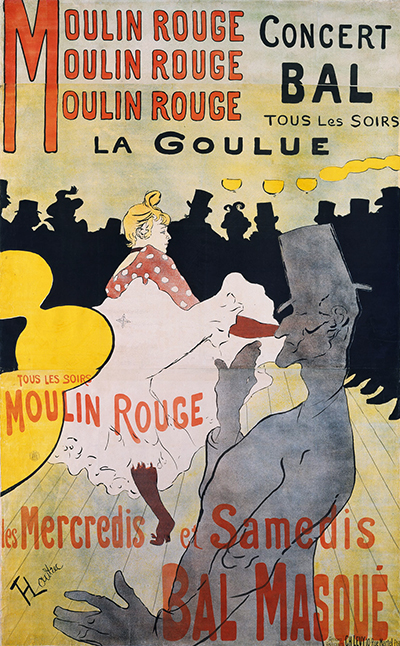The poster Moulin Rouge: La Goulue was executed by Henri de Toulouse-Lautrec, a French caricaturist, draughtsman, printmaker and painter. It's a colour lithograph produced in 1891, probably printed in around 3,000 copies; it advertises the famous dancers No-Bones Valentin and La Goulue, plus Moulin Rouge, a cabaret located in new Paris.
This poster is large measuring 170 cm by 118.7 cm, and it was printed in 3 parts. This copy is very unusual because it's still intact. However, the upper band, plus a large portion of the words written Moulin Rouge is missing. Although most examples of this poster were pasted as posters for advertising and lost, there are still some surviving examples in the collection of IMA (Indianapolis Museum of Art) at Newfields and other institutions.
The Moulin Rouge club had opened 2 years earlier (1889), and immediately established itself as a popular landmark in Montmartre. The club was famous for the flexibility of its young, beautiful dancers, both morally and physically. Police officers used to make periodic checks to make sure they were wearing underwear. By 1891, attendance had slumped, and Jules Chéret's poster advertising Moulin Rouge's delights was subdued.
As a result, Charles Zidler, who was the director of the club, hired the 27-year-old artist called Henri de to make a more vibrant poster. This poster was the artist's first attempt at lithography (a method of printing based on the immiscibility of water and oil), but Toulouse-Lautrec's grasp of the possibilities of the medium was amazing that it became an immediate sensation.
The outcome was sensational in its originality and scale, revealing his brilliance as a draughtsman. 3000 copies spread throughout Paris fascinated the public with their bold colour, striking design, plus innovative use of silhouettes inspired by Japanese art. Cannily focusing on La Goulue, whose insatiable appetites and energetic kicks had made her become famous, gave this poster an extra boost in popularity. However, it was Toulouse-Lautrec's artistic skill that made the artist to become a star overnight.
The four-colour lithograph was created to advertise Moulin Rouge, a popular French Club. Their audience has been reduced to silhouettes to make the performers centre of attention as well as evoke Japanese art, which was then in vogue. The club's name has been repeated three times to draw the focus of viewers down to La Goulue, who is the main figure of the poster. In front of the dancer La Goulue, there is her usual partner, the remarkable Valentin le Désossé. The gentleman amateur dance is wearing his signature attractive top hat and tails. The stark white of the petticoats worn by La Goulue, which are depicted with only a few lines on a white paper, encapsulates the printmaker's boldly simplistic style, which was a sharp break from that day's text-heavy posters.
Instead of depicting the venue he was advertising, a common technique for such publicity, Toulouse-Lautrec decided to focus on the performers. The Glutton (La Goulue) was popular because of her outrageous behaviour. In the poster, she is performing her famous high-kicking dance, and provocatively raises her hem and reveals her white frilly bloomers and red stockings. The scandalous dancer was even known for not wearing anything under her billowing skirt occasionally, which added to the dancer's notoriety.
The artist has depicted La Goulue's facial expression with sensitivity, which indicates her vulnerability. This skilful characterisation was not seen in posters before. The audience and the abruptly cropped Valentin's silhouettes add to this composition dynamism. The bright, deep black, solid colours seen in the poster make it a masterpiece. The naturalism of Lautrec's earlier style as an impressionist gave way to the large swaths of flat colours and strong outlines as well as generalised silhouettes that inform the artist's lithographs. He was collecting and studying Japanese Ukiyo-e prints before he was commissioned to make this poster. Also, there is an Art Nouveau aesthetic style used when it comes to the graphic nature plus the suggested curves.
In poster design history, Lautrec has remained its most outstanding figure and this poster is very iconic. In fact, the original Moulin Rouge: La Goulue remains one of the unique and is, therefore, particularly desirable for the collection of national art. In the fall of 1891, no one would have predicted that Moulin Rouge: La Goulue would become within a few days a collected item. Just after some few weeks, it had become the object of press reviews and after several months, it went to the avant-garde exhibitions as the partner of paintings. Within 12 months, the poster was internationally recognised as the symbol of 1890s Paris. Lautrec perfected the art of portraying people at work; the typical setting the paintings he executed were the gaudy and exhilarating nightlife.




